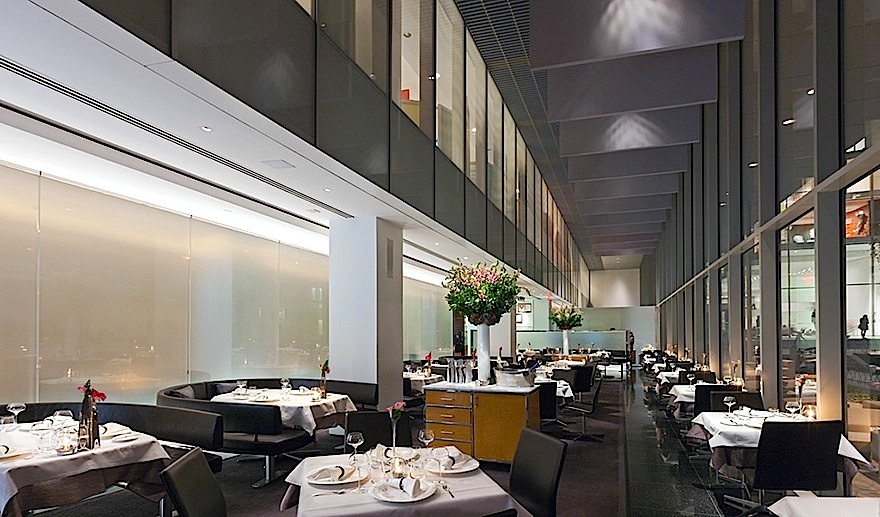MARIANI’SVirtual
Gourmet
March 24,
2013
NEWSLETTER

Jean Arthur at the NYC Automat in "Easy Living" (1937)
THIS WEEK
CHARLESTON SURGES
by John Mariani
NEW YORK CORNER
by
John Mariani
Notes from the
Wine Cellar
The Wines of Argentina
by John Mariani
❖❖❖
CHARLESTON SURGES
by John Mariani
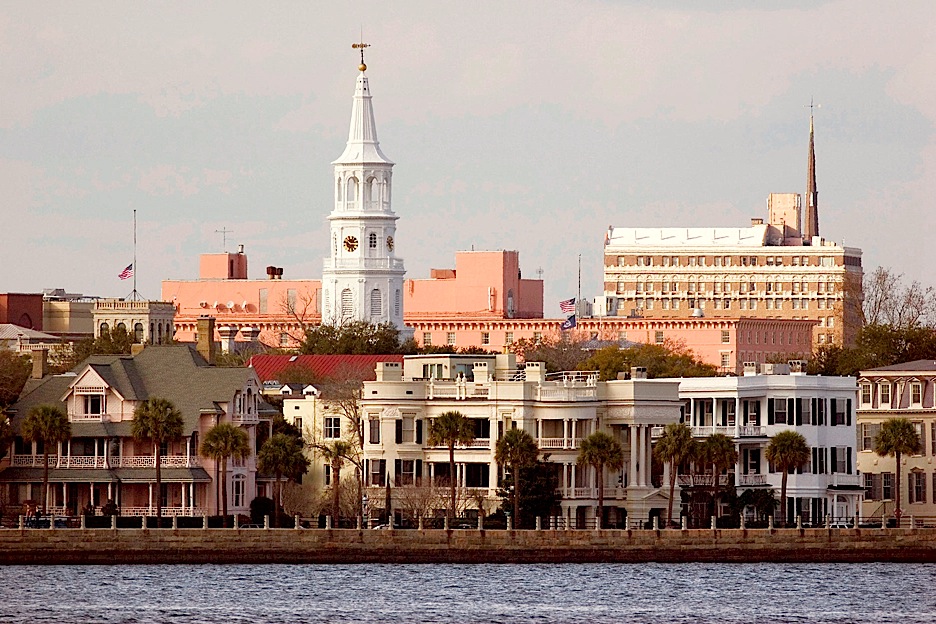
Charleston continues its
remarkable surge as an American food city, and
anyone doubting it should attend the annual Charleston Wine + Food
Festival, which just concluded three weeks ago. Now in
its eighth year—and I have attended and hosted
events most years—the focus is still on the
cuisine of the South, and the wide majority of the
chefs invited to the festival come from the
region, although many come from all over the
country, too.
Unlike the annual food and wine festivals
in Aspen and Miami, which depend almost entirely
on the same tired TV food and travel show
celebrities, Charleston celebrates new people each
year, and they have a lot of great talent to
choose from: this year the invitees included Art
Smith of Art and Soul Restaurants, The Lee Bros.,
Ryan Smith, Katie
Button, Sarah
Simmons, John T. Edge, Barbara Lynch, Nicholas
Stefanelli, Tandy Wilson, and many others.
The "Heart of the Festival" is
the tented Culinary Village, where back-to-back
demos, book signings, and music jams are held
throughout each day. Testament to the success and
popularity of the Festival is not just that it's
grown, but that its various events sell out weeks
in advance. Next year I expect it to be
bigger and better than ever. The 2014 event will be
held Feb. 27 to March 2.
Of course, I got to eat around town, including
some impressive new places opened since the last
Festival, all showing the traditional depth and
the continuing innovation of the city's cuisine.

192
East Bay Street
843-723-3424
slightlynorthofbroad
Of
all the chefs working in Charleston today, none
has a longer or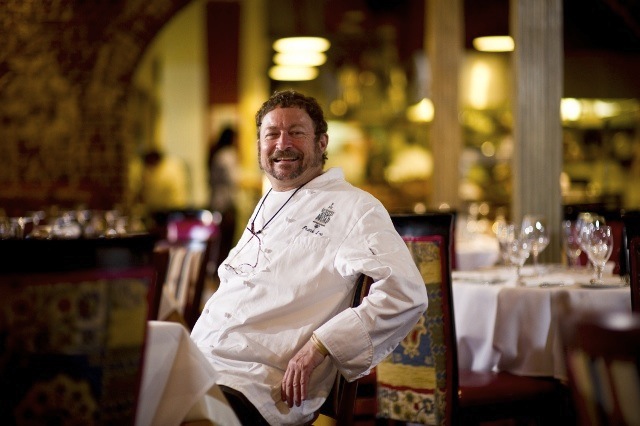 more
respected tenure than Frank Lee--and I mean a
working chef who daily puts in his time on the
line at the Maverick Southern Kitchens
restaurants, of which Slightly North of Broad
(SNOB) is now two decades old. Over those years,
Lee (right)
has become a master of Low Country Cuisine and has
a thick binder of sources for the best foods
available in any season. Along with veteran chef
de cuisine Russ Moore, Lee has been turning out
traditional and innovative Southern cooking with
panache, in a dining room (with open kitchen)
whose conviviality is part of the draw. SNOB is
always packed with locals for whom it is a regular
lunch or dinner place, and the tourists fill in
every other chair.
more
respected tenure than Frank Lee--and I mean a
working chef who daily puts in his time on the
line at the Maverick Southern Kitchens
restaurants, of which Slightly North of Broad
(SNOB) is now two decades old. Over those years,
Lee (right)
has become a master of Low Country Cuisine and has
a thick binder of sources for the best foods
available in any season. Along with veteran chef
de cuisine Russ Moore, Lee has been turning out
traditional and innovative Southern cooking with
panache, in a dining room (with open kitchen)
whose conviviality is part of the draw. SNOB is
always packed with locals for whom it is a regular
lunch or dinner place, and the tourists fill in
every other chair.
To show just how innovative Lee
is these days, I asked him to cook up some of this
new ideas. Without a moment's thought, he went
back to the kitchen and dazzled me. Many of
these items are not on the day-to-day menu, but
they do appear as specials. I'll let Frank
tell you what I ate:
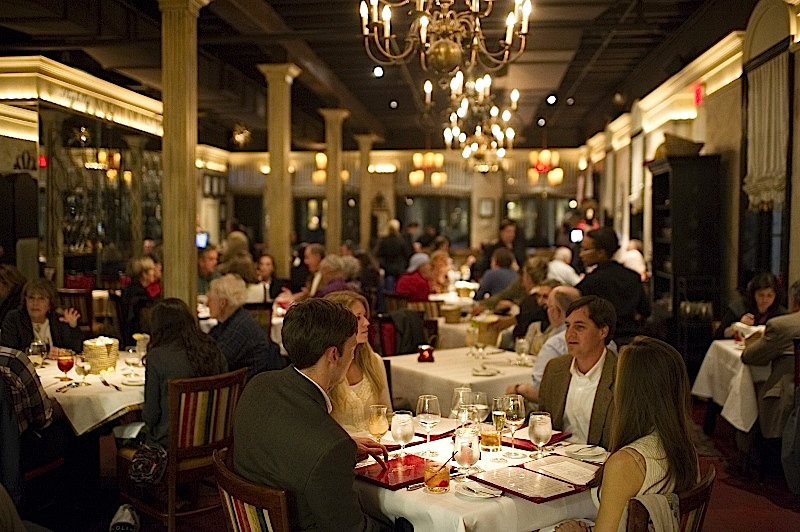 "We started you off with a version of our chilled
shrimp salad, which were local McClellanville
shrimp, tossed with a little avocado and black
cherry tomatoes from our hydroponic grower, Kurios
Farms. That was all tossed in a dressing of
olive oil, hard boiled egg, and lemon juice, with
a single Bibb lettuce leaf. We proceeded
with a spicy shrimp broth, enriched with lemon
grass, ginger, etc. to which we added minuscule
slivers of our pork belly brined in smoke, from
our pig grower, Keegan Farms, along with slivers
of green beans, purple pearl onions, and a fennel
bulb. Following the soup course, you enjoyed
a tuna carpaccio topped with Nantucket Bay
scallops, which had been lightly dressed with
fresh blood orange and a lovely California olive
oil. We then went to our daily special,
which
"We started you off with a version of our chilled
shrimp salad, which were local McClellanville
shrimp, tossed with a little avocado and black
cherry tomatoes from our hydroponic grower, Kurios
Farms. That was all tossed in a dressing of
olive oil, hard boiled egg, and lemon juice, with
a single Bibb lettuce leaf. We proceeded
with a spicy shrimp broth, enriched with lemon
grass, ginger, etc. to which we added minuscule
slivers of our pork belly brined in smoke, from
our pig grower, Keegan Farms, along with slivers
of green beans, purple pearl onions, and a fennel
bulb. Following the soup course, you enjoyed
a tuna carpaccio topped with Nantucket Bay
scallops, which had been lightly dressed with
fresh blood orange and a lovely California olive
oil. We then went to our daily special,
which 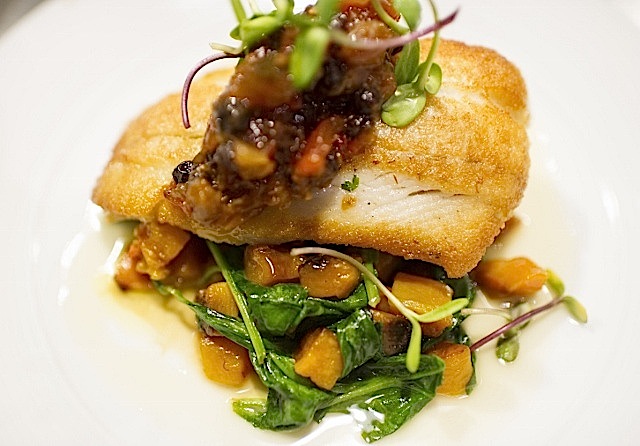 was a
roast stuffed pork loin, over a sauté of
crispy potatoes and Brussels sprouts, with a
little fried chicken liver, caramelized onion
gravy, and a tiny dot of reduced Port wine
gastrique on the chicken liver. We then gave
you a samplings of sweet trinkets: a salty caramel
with toasted hazelnut, a lemon bar, and a
chocolate truffle rolled in pecans."
was a
roast stuffed pork loin, over a sauté of
crispy potatoes and Brussels sprouts, with a
little fried chicken liver, caramelized onion
gravy, and a tiny dot of reduced Port wine
gastrique on the chicken liver. We then gave
you a samplings of sweet trinkets: a salty caramel
with toasted hazelnut, a lemon bar, and a
chocolate truffle rolled in pecans."
It was a sumptuous but
curiously light lunch, the tastes and textures in
lovely equilibrium, lots of spice and bright acids
throughout. Such dishes go very well with SNOB's
regular menu, which contains dishes like
SNOB is a template for all the
fine restaurants that have followed in
Charleston, and Lee is a chef's chef who still
walks the walk.
Lunch, Mon.-Fri.,
dinner nightly. Appetizers $7-$14, main courses
$18-$29.
 RUTLEDGE
CAB. CO.
RUTLEDGE
CAB. CO.
1300 Rutledge Avenue
843-720-1440
rutledgecabco.com
Almost
as long as Frank Lee has been cooking in
Charleston, so has the redoubtable Robert Carter,
whose years at the genteel Peninsula Grill gave
the city its finest dining room. Two years
ago he left to open his own place, Carter's
Kitchen, across the bridge in Mt. Pleasant, which
was more casual but showed the range and depth of
the man's talent for bringing up the flavors of
Southern cuisine. (It was one of my 20 Best New
Restaurants of 2012 in Esquire.)
Now, he's gone downscale with a
big, brash, welcoming splash at the Rutledge Cab
Company, whose name was taken whole from a
previous tenant. The door is made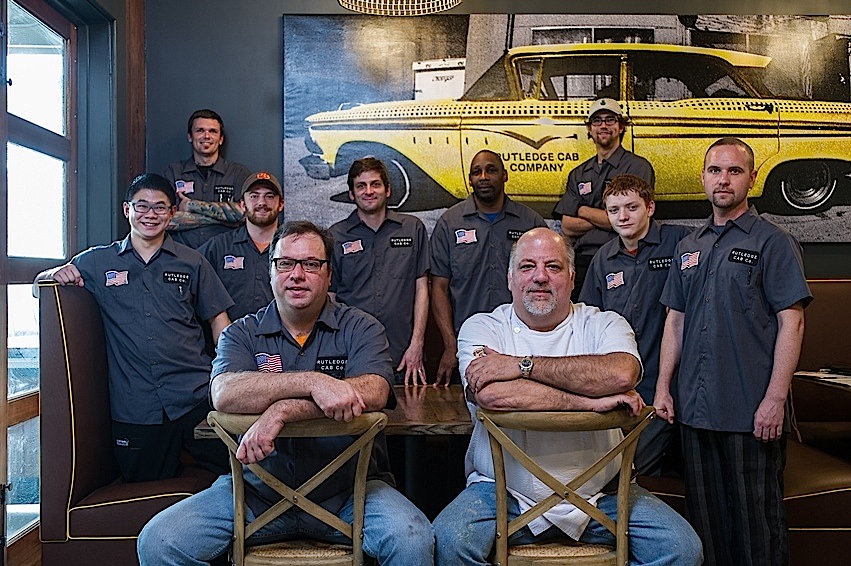 of faux
alligator, the lot outside has bike racks, the
patio is a great place for a cocktail, and inside
the booths are roomy, the bar scene jamming, and
the artwork--like the taxi cab to the left--is
terrific.
of faux
alligator, the lot outside has bike racks, the
patio is a great place for a cocktail, and inside
the booths are roomy, the bar scene jamming, and
the artwork--like the taxi cab to the left--is
terrific.
The menu is big and offers
something for everyone, and I trust Carter (far right)
will cut it down when he sees what works
best. Right now the menu has a lot of
well-rendered bar food, four flatbreads, four
salads, nine sandwiches, burgers (five of them),
grilled dishes, including five kabobs, sides and
desserts, not to mention some really delicious
milkshakes as thick as lava.
There's a generous platter of
charcuterie (below)
with cheeses, potted meats, country ham, even
fried bologna--a steal at $12--and the French
onion soup is sweet with plenty of
long-caramelized onions, though the rye bread did
little for the soup. There's even a cheddar
cheese and beer fondue with smoked sausage, soft
pretzels, broccoli, cherry tomatoes and apple to
dip. It can easily served four as an app.
The flatbreads are heartily
mounted with ingredients like roasted potato and
blue cheese of BBQ shrimp with goat's cheese,
cilantro and pickled onions. The corned beef in
the Reuben at Rutledge 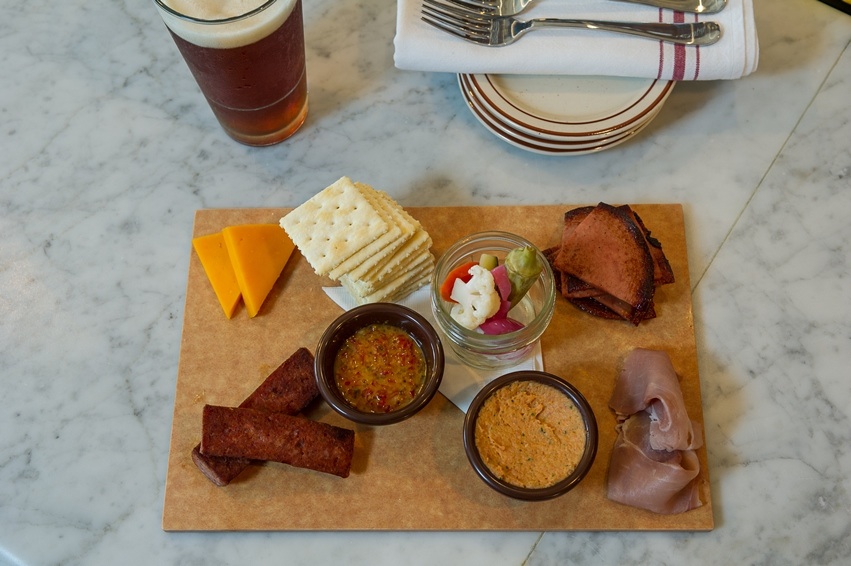 doesn't
rank with the best in NYC (northerners do some things
better than in the South!), but the roasted lamb
sandwich with Harvarti cheese took on some real
zing from pickled cabbage, on a warm toasted
hoagie roll. The eight-ounce burgers take on a
whole array of ingredients, including tempura
fried poblanos and a savory smoked onion
aïoli. The beef is house ground and perfectly
cooked.
doesn't
rank with the best in NYC (northerners do some things
better than in the South!), but the roasted lamb
sandwich with Harvarti cheese took on some real
zing from pickled cabbage, on a warm toasted
hoagie roll. The eight-ounce burgers take on a
whole array of ingredients, including tempura
fried poblanos and a savory smoked onion
aïoli. The beef is house ground and perfectly
cooked.
From the grill menu we had lamb
kabobs with mint pesto; a nice slab of swordfish
with herbed wild rice and tomato ginger relish;
and BBQ glazed smoked ham chop with garlic spinach
and peach relish, which rated among our group of
five people as the best of the evening. French
fries go with everything here, and that's a good
thing.
I've already remarked on
the chocolate milkshake, but there is also a red
velvet cake that might be a new signature for
Carter. Southern pecan pie was, admirably, mostly
pecans and not too sweet. There's also a
chocolate fondue available.
Rutledge Cab Company fits
into its neighborhood snugly and with good
feelings. Located just outside of downtown,
it's an easy cab ride for visitors to
Charleston. For locals, it's a cheery
addition full of generosity of spirit and good
eats. It's a square meal for a
square deal.
The Ordinary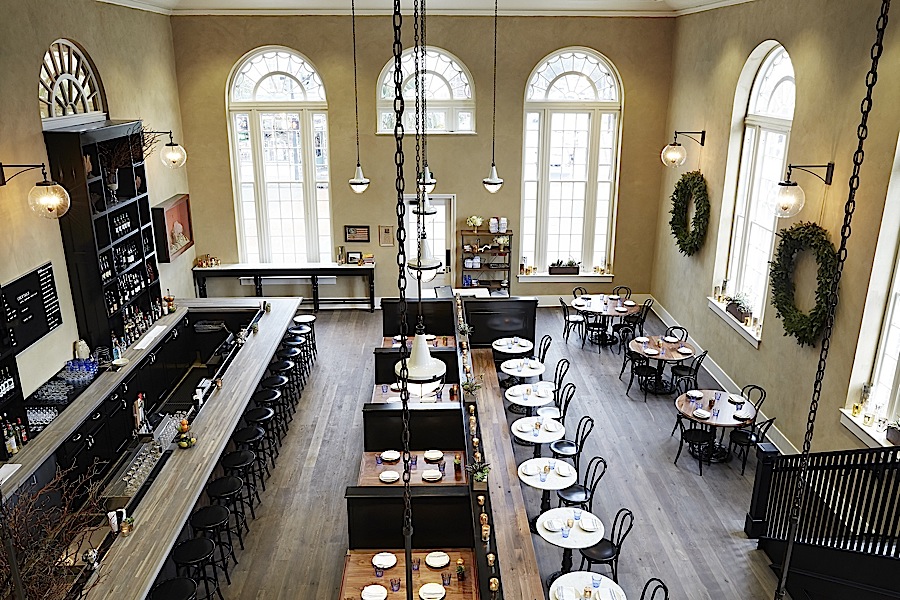
544 King Street
843-414-7060
eattheordinary.com
Charleston--and the national
food media--has been waiting for Mike Lata to open
a new restaurant, since his first one, Fig, has
long been among the most praised in the country
and is always packed. Lata (below) took his
time and now The Ordinary is his big new place
right on King Street, located in what had been a
bank building, with all the historic lineaments
and decorous touches left intact, from the
beautiful 16-foot Palladian arched windows to the
Local artist Becca 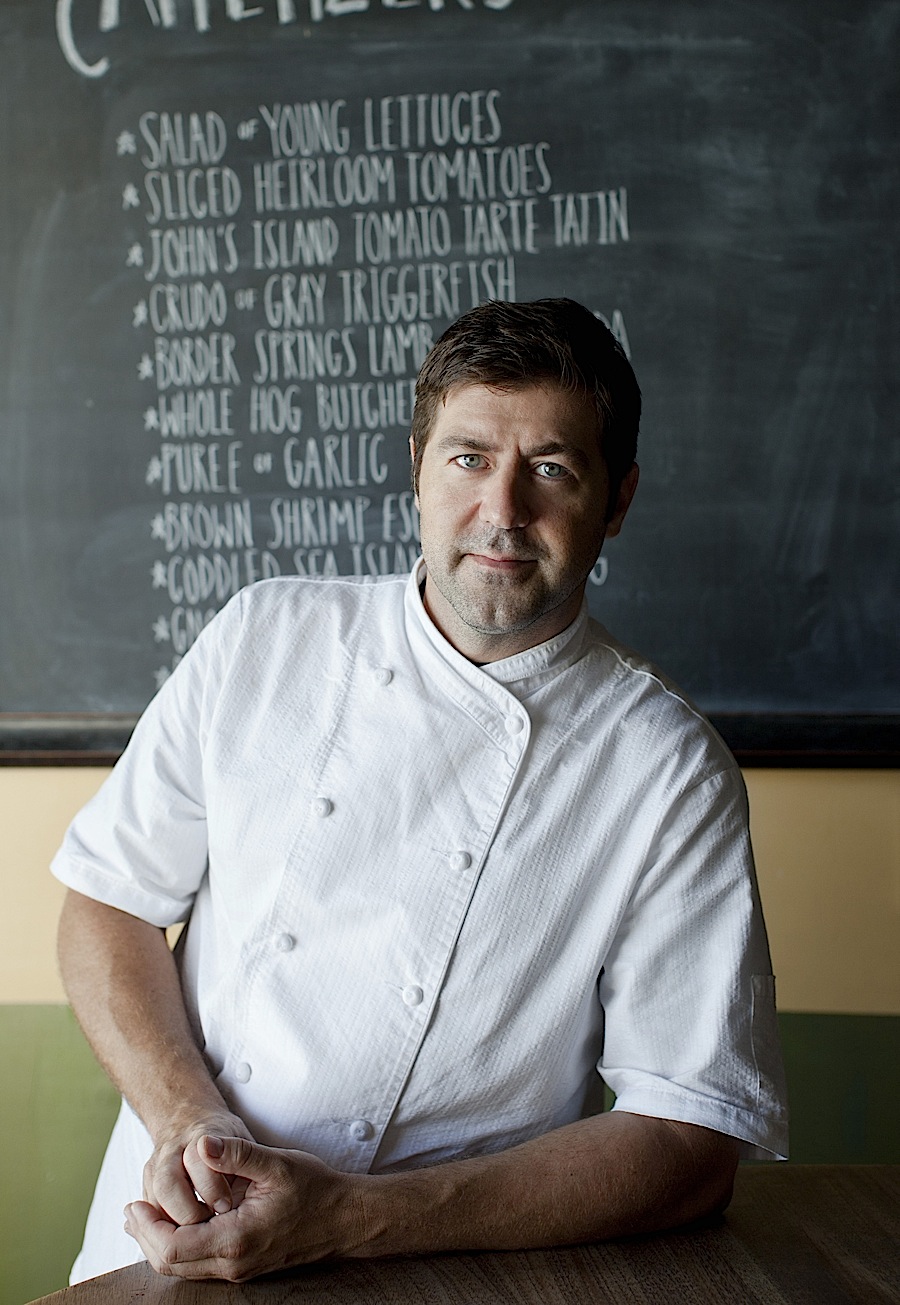 Barnet
fabricated shadowbox installations with preserved
marine life, and the lighting is simply perfect to
let everyone see each other in the large room with
mezzanine and to add conviviality to the space.
There is a six-seat marble raw bar, and the
floor and bar are made from reclaimed wood.
Without any sense of showiness, the entire design
comes together as an immediate model of good
contemporary taste.
Barnet
fabricated shadowbox installations with preserved
marine life, and the lighting is simply perfect to
let everyone see each other in the large room with
mezzanine and to add conviviality to the space.
There is a six-seat marble raw bar, and the
floor and bar are made from reclaimed wood.
Without any sense of showiness, the entire design
comes together as an immediate model of good
contemporary taste.
That goes for the menu, too,
which is deliberately composed so that the guest
can take in and desire everything on it, starting
with the array of oysters each night, along with
the shellfish platters ($65-$125) lavished with
peel and eat shrimp, clams, lobsters, and other
shellfish. There is a cold section that
includes a finely grained smoke trout pate with
brown bread; a delectable skate wing and potato
terrine with rémoulade sauce; "porchetta"
tonnato with lemon and olive oil; and hot
starters, including a clam cake with coriander and
crème fraîche, and braised, nicely
mild, uni with a Yukon puree, mustard and
lemon. You can readily tell that Lata does
not want to mess up his ingredients with too many
others, so that the primary star shines on the
palate.
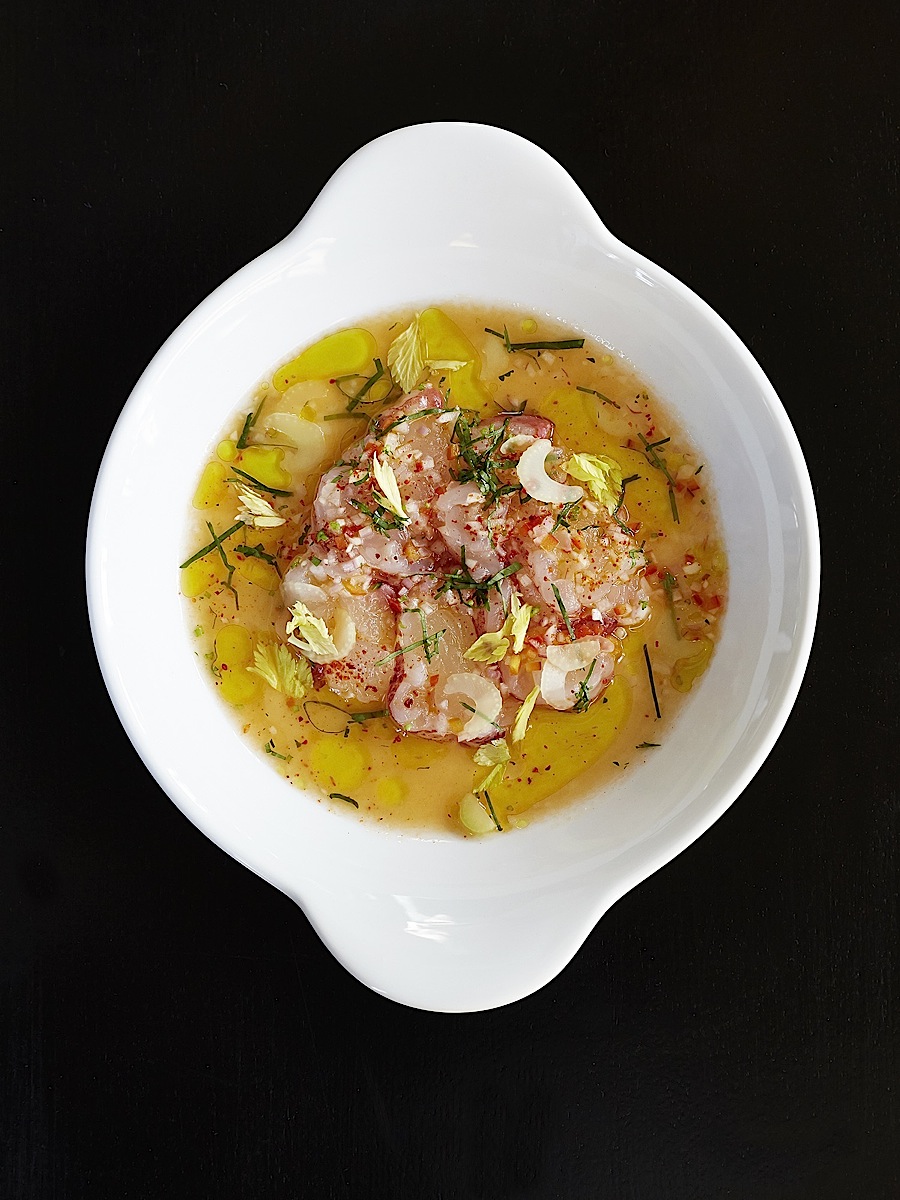 Among
the main courses are grilled Spanish mackerel,
wahoo with steak fries, and my favorite that
night, triggerfish--a species you rarely see on
menus--done as a crisp schnitzel, with a simple
brown butter vinaigrette.
Among
the main courses are grilled Spanish mackerel,
wahoo with steak fries, and my favorite that
night, triggerfish--a species you rarely see on
menus--done as a crisp schnitzel, with a simple
brown butter vinaigrette.
For dessert don't miss the
Carolina gold rice pudding--as homey a dish in the
South as it is everywhere else--and a crisp
apple-almond tart.
The wine list teems with
unexpected rarities, most under $60, all chosen
with care, and there is also a category for
sherry, cider, and Madeiras. And the cocktails
here are made impeccably, always with fresh fruit
juices and the best spirits.
The Ordinary's name is belied
by everything from décor to service, from
food to drink, here. It took Lata awhile to
get it right. In the end, he got it very very
right.
The Ordinary is open for dinner Tues.-Sun.;
Appetizers $$10-$25, main courses $24-$27.
CHARLESTON
GRILL
Charleston Place
224 King Street
843-577-4522
charlestongrill.com
The Charleston Grill has always
been the city's big deal dining room, with a
heritage of great chefs that have included Louis
Osteen and Robert Waggoner. Now, the Grill has its
first woman in the kitchen, and the management's
decision not to dumb down the splendid, polished
grandeur of the dining room and bar is matched by
its support of Alabama-born Chef Michelle Weaver
in her dedication to all the finer points of fine
dining.
After schooling at the New
England Culinary Institute, Weaver moved to New Orleans to work,
then to Nashville, where she worked for Waggoner
at The Wild Boar restaurant, traveling with him to
The Charleston Grill in 1997; so she has unique
experience with the kitchen and service here. The
service, by the way, is overseen by one of the
real pros of the industry, Mickey Bakst,
whose knowledge of every aspect of hospitality,
food and wine makes him a formidable maître
d' in the truest sense.
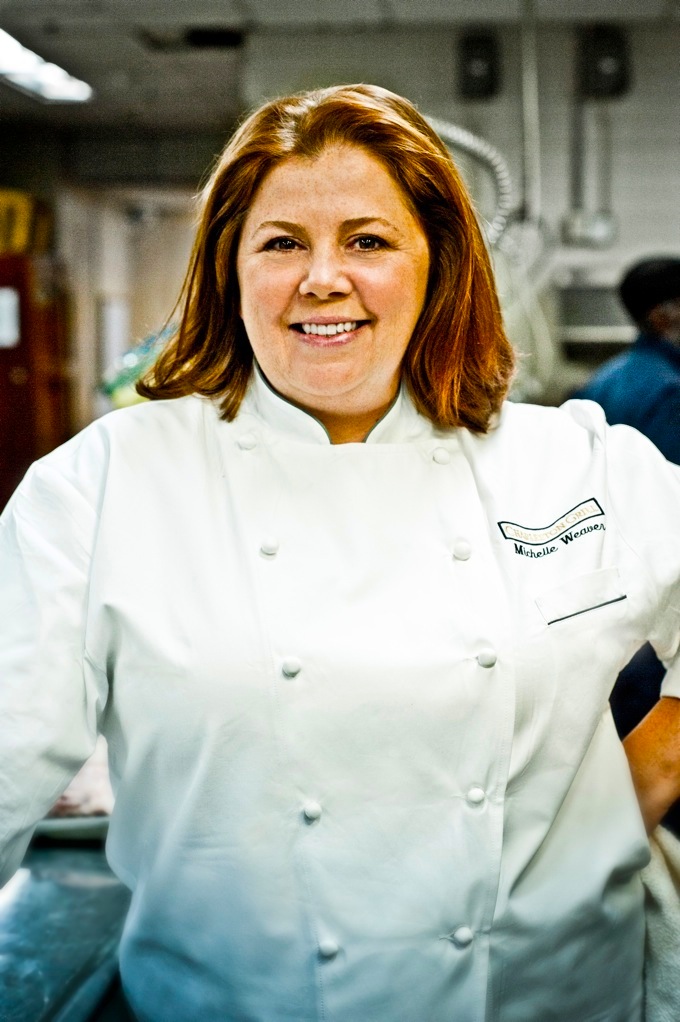 The menu is
divided, somewhat awkwardly, into four categories
of culinary style, though you can choose among any
of them to make your meal. The Southern dishes are
contemporary interpretations of regional
favorites; the Pure menu items are simple dishes
inspired by the clean, light flavors of the
ingredients; the Lush dishes come from the French
The menu is
divided, somewhat awkwardly, into four categories
of culinary style, though you can choose among any
of them to make your meal. The Southern dishes are
contemporary interpretations of regional
favorites; the Pure menu items are simple dishes
inspired by the clean, light flavors of the
ingredients; the Lush dishes come from the French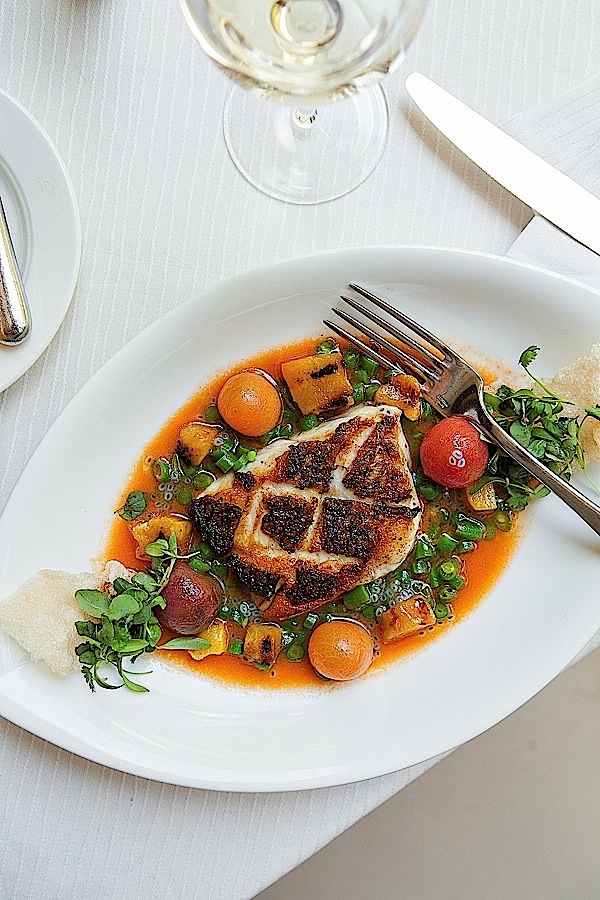 tradition
of extravagance; and the Cosmopolitan dishes
are exotic and imaginative. That shows
Weaver's range, which, largely, she delivers on.
tradition
of extravagance; and the Cosmopolitan dishes
are exotic and imaginative. That shows
Weaver's range, which, largely, she delivers on.
I won't bother to note which
dishes I had came from what category, for I
ordered from all of them: sweetbread piccata was
crispy indeed, graced with capers, artichokes, the
nice touch of bacon, and bracing lemon.
Seared foie gras was superb, accompanied by
apples, bourbon-cider sauce, and delightful
gingerbread. Happily, I enjoyed once again
the signature crab cake here--very plump with all
lump meat--with shrimp,and a lime-tomato
vinaigrette.
A Colorado
rack of lamb could not have been juicier or more
flavorful, served with a rich potato puree, the
scent of thyme emulsion and lamb jus, while
the hearty Southern style showed through in
Frogmore stew, with crab, shrimp, clams, potatoes,
corn, and andouille, a dish whose ancestry dates
to St. Helena Island, SC.
I also ordered Thai fish, which
I suspected might not be up to all else I was
served, but Weaver came through with a perfectly
cooked fish with grilled pineapple, cherry,
tomatoes, and a basil salad, which just begged to
be accompanied by kimchi fried rice, which I
gobbled up down to the last grain.
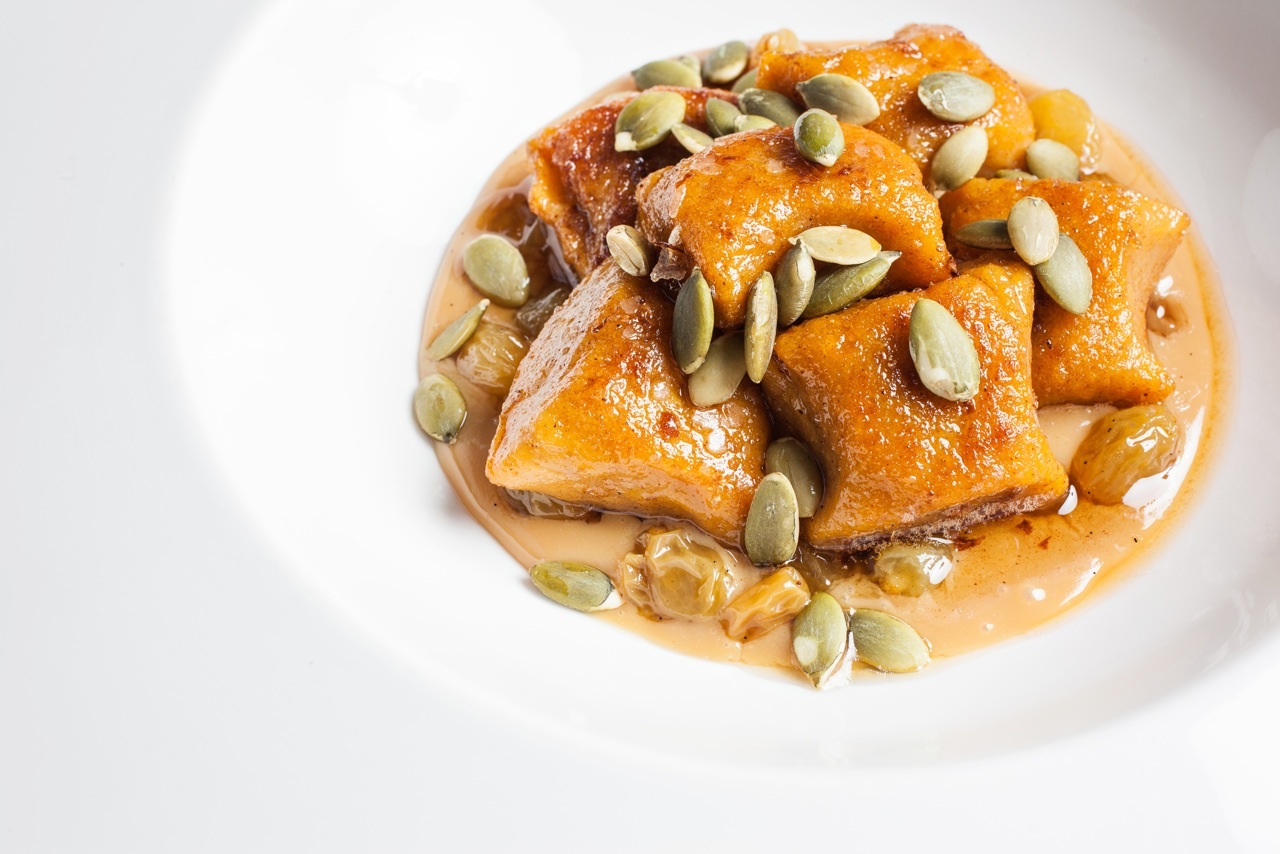 Three
desserts, by pastry chef Emily Cookson, showed
very well, especially the sweet potato gnocchi, an
unexpected surprise, with dulce de leche, brown
butter, golden raisins, and pumpkin seeds.
Three
desserts, by pastry chef Emily Cookson, showed
very well, especially the sweet potato gnocchi, an
unexpected surprise, with dulce de leche, brown
butter, golden raisins, and pumpkin seeds.
It was so good to be back in
that beautiful dining room, entertained by an
excellent jazz group and sipping a 1977 Boal
Madeira with my dessert. At a time
when genteel Southern dining has given way
to trendiness and little but the basics, the
Charleston Grill holds its banner high and with
pride that comes from a generation of great chefs.
Charleston Grill is open for dinner
nightly. Appetizers $12-$19, main courses
$27-$59. Six-course tasting menu $90, with wines
$60-$120.
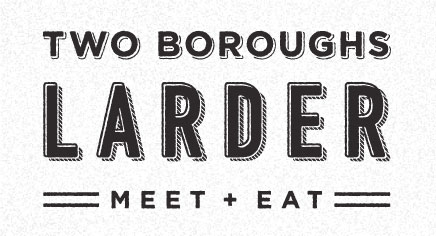
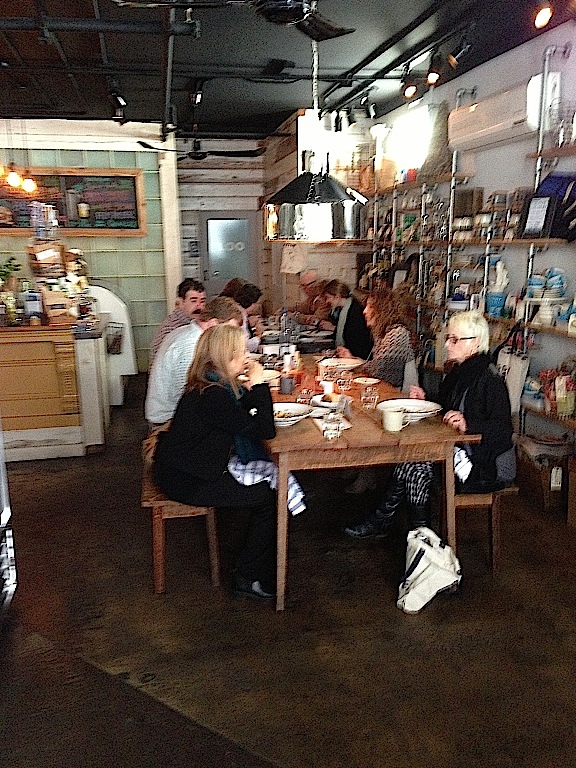
186 Coming Street
843- 637 - 3722
twoboroughslarder.com
I'll make no
real judgment about Two Boroughs Larder because I
ate there on a day when the communal table was
taken over by attendees at the Charleston Wine +
Food Festival, and the owner was nice enough to
give me a corner table and serve me the day's set
menu. But so many people asked me about the
place, having gotten considerable press, that I
feel a preliminary report is required.
Basically it's an
out-of-the-way storefront next to an old seafood
house. The interior resembles more that of a
grocery store, with pots and pans, towels and
beers, and distressed wood, than a restaurant; the
kitchen is off to one side, where
Pennsylvania-raised Chef Josh Keeler works the
stoves while his wife Heather takes care of
customers. The name refers to the building's
location between Elliotborough and Cannonborough
and it does resemble an open larder.
 Despite a meal in which
everyone got the same dishes, there were long
waits between them. We began with some
first-rate sourdough bread with sea salt, which
came in handy while waiting for the lamb bacon
with mole
sauce and fromage
blanc--a pleasant breakfast or brunch
dish, though the seasoning was slight and the mole needed
snap. So, too, simple salt and pepper would
have much improved some lackluster rabbit loin and
confit with a fried egg and Ansel Mills
oats. For dessert there was a sticky bun
with Benton's bacon (bacon twice in one
three-course meal?), bitter chocolate and carrot,
which was good if not stunning.
Despite a meal in which
everyone got the same dishes, there were long
waits between them. We began with some
first-rate sourdough bread with sea salt, which
came in handy while waiting for the lamb bacon
with mole
sauce and fromage
blanc--a pleasant breakfast or brunch
dish, though the seasoning was slight and the mole needed
snap. So, too, simple salt and pepper would
have much improved some lackluster rabbit loin and
confit with a fried egg and Ansel Mills
oats. For dessert there was a sticky bun
with Benton's bacon (bacon twice in one
three-course meal?), bitter chocolate and carrot,
which was good if not stunning.
The Keelers are obviously
cooking with dedication and good ingredients, and
media attention should bring them more
business. If so, I trust they will develop
the acumen to make all go smoothly and efficiently
in and out of the kitchen. I'll go back for
dinner some time and see what time has done for a
place that needs to turn quaintness into a real
culinary experience.
The
restaurant is open Tues.-Sat., from 10 AM until 10
PM. Average dinner price, about $30.
Back in 2005 when The Modern
opened adjacent to the newly designed Museum of Modern
Art, I named it the Best New Restaurant of the Year in
Esquire. And
if it had opened in 2013, I'm pretty sure I would
award it the same honor today.
Eight years ago I described The
Modern as restaurateur Danny Meyer's masterpiece, with a
glass rich décor by Peter Bentel, a Bar dining
area (below)
that is packed from lunch through dinner, and a main
Dining Room (right)
so distinctive that it will endure as a classic of New
York sophistication and urbanism, overlooking, as it
does, the Museum's glorious sculpture garden.
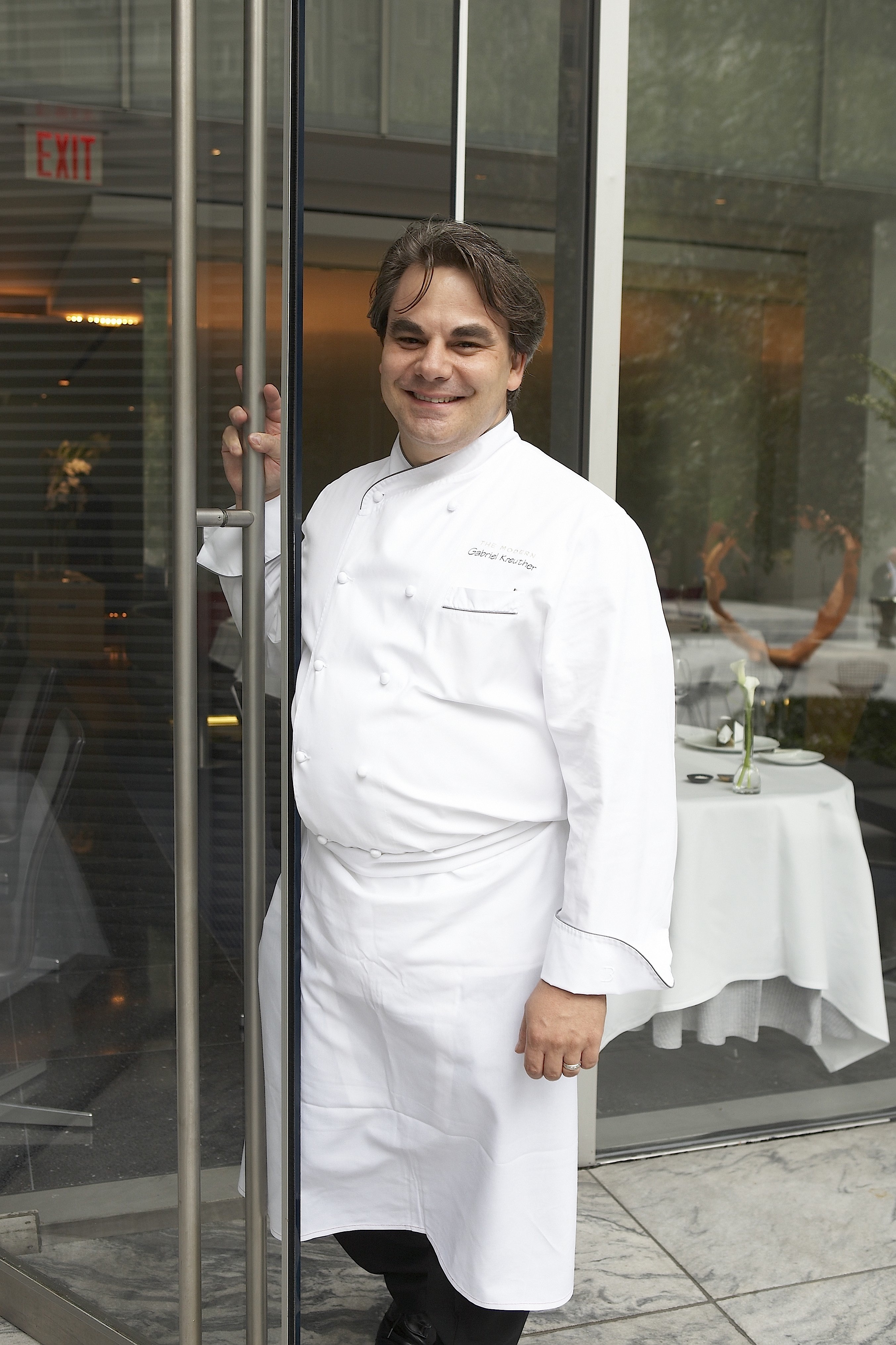 The restaurant
has worn those eight years well: last night, both dining
rooms were packed, and I, in the main section, was again
amazed at the striking beauty of it all, with its huge
flower displays (which must cost a small fortune), the
fine linens and stemware, the leather banquettes that
you slide smoothly across, and a waitstaff that proves
that dining at this level demands a specialized style of
highly informed servers whose respect for the guest is
mutual. Lighting is soft and complimentary to
everyone--at least until they turn the lights down
around 9 PM for some unnecessary reason. Most men wear
jackets and ties, and women dress up with
pleasure--though I'm not at all fond of the waiters'
strange new shirts with stranger black neck pieces.
The restaurant
has worn those eight years well: last night, both dining
rooms were packed, and I, in the main section, was again
amazed at the striking beauty of it all, with its huge
flower displays (which must cost a small fortune), the
fine linens and stemware, the leather banquettes that
you slide smoothly across, and a waitstaff that proves
that dining at this level demands a specialized style of
highly informed servers whose respect for the guest is
mutual. Lighting is soft and complimentary to
everyone--at least until they turn the lights down
around 9 PM for some unnecessary reason. Most men wear
jackets and ties, and women dress up with
pleasure--though I'm not at all fond of the waiters'
strange new shirts with stranger black neck pieces.
Executive chef Gabriel Kreuther is
still here, every day and night, working and coaxing the
best from his kitchen staff. (My son, in fact,
once worked at The Modern as a cook and learned
everything about finesse from the experience as well as
the commitment to making the next dish better than the
first.) Kreuther has said, “The idea of
modernism opens a door to creation but also a more sleek
and streamlined presentation with a more purist
side. You take things off instead of adding them
in." And so, right from the start of our meal,
canapés like pickled raspberry with foie gras
mousseline and rye crumble; brined duck breast with
whipped mustard grain; and fennel-saffron soup with red
pepper marmalade showed off exactly what he meant by
restraint and intensification of flavors and textures.
What followed was the kind of meal
that keeps me from ever being jaded in my job: pralines
of foie gras terrine (below)
with mango puree and a touch of balsamic vinegar; a
rabbit terrine dashed with gewürztraminer wine
(Kreuther is from Alsace), a faint touch of anise, and fines herbes;
lustrous hamachi
with black truffles shavings and more foie gras.
Ingredients count for everything here.
Key West pink shrimp were served raw,
with a cucumber vichyssoise, kumquat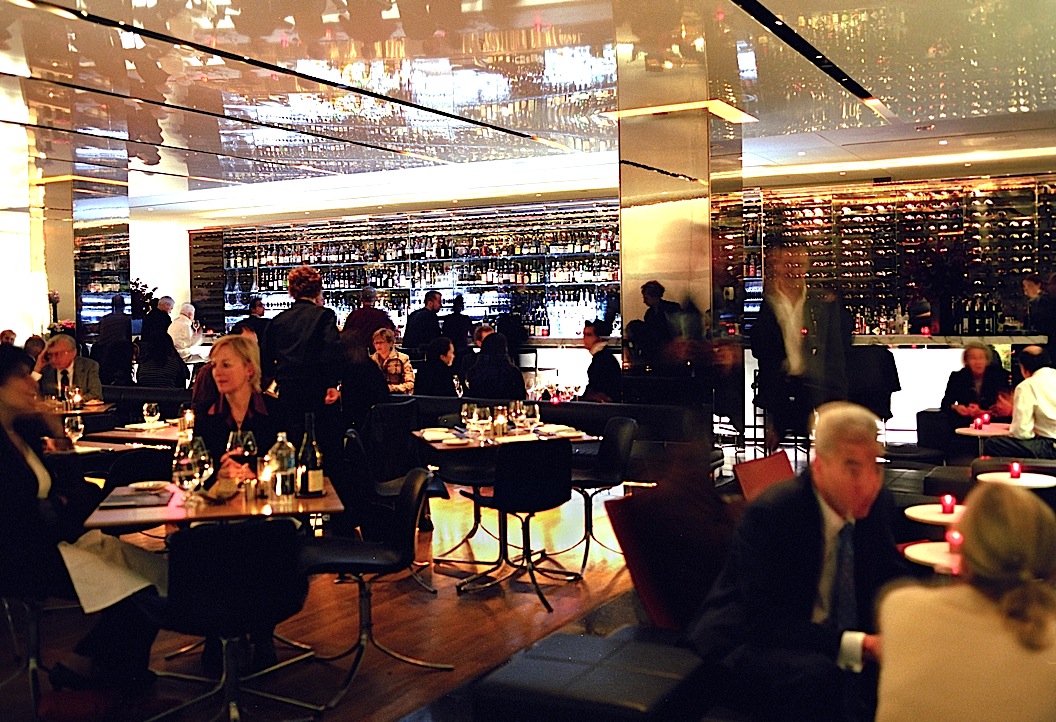 confit, and a
little mint oil, while Alsatian dumplings stuffed with
tender, moist rabbit and truffles had the subtle
accompaniment of sunchoke and crystal lettuce. A
fine morsel of foie gras was poached in cabernet wine,
with baby fennel and a black pepper caramel that
sweetened and balanced the wine. One of the
heartier dishes of the night was a Münster-Brie
soufflé with almond crumble and a bright carrot
consommé.
confit, and a
little mint oil, while Alsatian dumplings stuffed with
tender, moist rabbit and truffles had the subtle
accompaniment of sunchoke and crystal lettuce. A
fine morsel of foie gras was poached in cabernet wine,
with baby fennel and a black pepper caramel that
sweetened and balanced the wine. One of the
heartier dishes of the night was a Münster-Brie
soufflé with almond crumble and a bright carrot
consommé.
Again showing his Alsatian roots,
Kreuther brought forth a delightful combination of
sturgeon and sauerkraut in a tart dotted with American
caviar mousseline smoked over applewood. This was
followed by a gratinée of John Dory with beggar's
purses of mussels and a colorful pimento glaze. The last
of the seafood dishes was a roasted lobster in Pernod,
with a kohlrabi puree and ham emulsion.
The meat dishes arrayed before us
included quail with a macaroni gratiné, spinach and
chanterelle mushrooms; succulent rack of lamb with olive
and fines herbes--a
touch of the Mediterranean--bacon fondue and crisp
onions; and slowly roasted Scottish salmon with fennel,
a risotto gâteau
and pistachio emulsion.
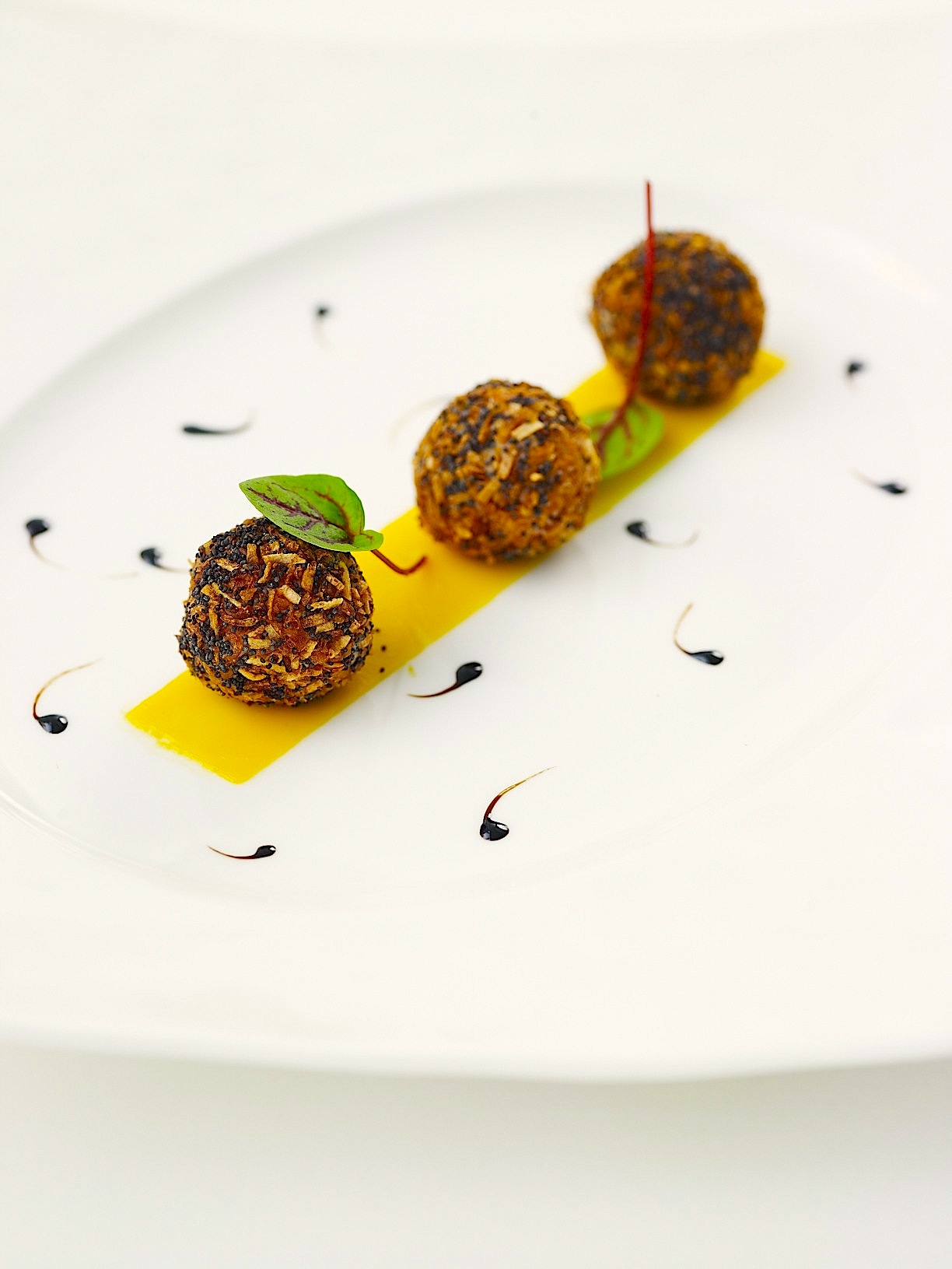 Note how
Kreuther never lavishes any main ingredient with
anything that would tone down its essential flavor;
everything adds in small, counterpoint ways. This
is also true of pastry chef Marc Aumont's mango craquelin with
citrus mousseline, almond "spaghetti" and mango-passion
fruit sorbet; his pain
d'épices feuilletine with lemon cream
and Mandarin sorbet is a marvel.
Note how
Kreuther never lavishes any main ingredient with
anything that would tone down its essential flavor;
everything adds in small, counterpoint ways. This
is also true of pastry chef Marc Aumont's mango craquelin with
citrus mousseline, almond "spaghetti" and mango-passion
fruit sorbet; his pain
d'épices feuilletine with lemon cream
and Mandarin sorbet is a marvel.
We thought ourselves sated and
happy, but then they wheeled over a novelty here--a huge
cart of chocolates, caramels, and cookies--the kind of
ending one can only expect these days from a restaurant
of this caliber.
Not in any quarter--food, service, or
wine list (one of astounding depth and breadth, overseen
by sommelier Ehren Ashkenazi)--does The Modern shrink
from consistent excellence. At a time when
some--thank god, not all--food media are insisting that
restaurants and haute cuisine like The Modern's is
passé and not even very popular, this splendid
place of great beauty and elegance continues to enjoy
the patronage of those who know the finest and can
distinguish from the fads of the present season.
Add to this a fixed price of $98 for four courses
(Kreuther sent out a few more to our table), with the
additions of canapés, amuses, chocolates, and candies--and a
little box to take some home in--and you have an evening
whose pleasures cloud never be curdled by a sense of
flagrant spending.
The Modern is open at
the Bar for lunch and dinner daily, with the main
dining room open for lunch Mon.-Fri. and dinner
Mon.-Sat.
❖❖❖
NOTES FROM THE WINE CELLAR
Cash and Milk
May Be Hoarded in Argentina,
but There’s Plenty of Good Wine to Be Found
by John Mariani

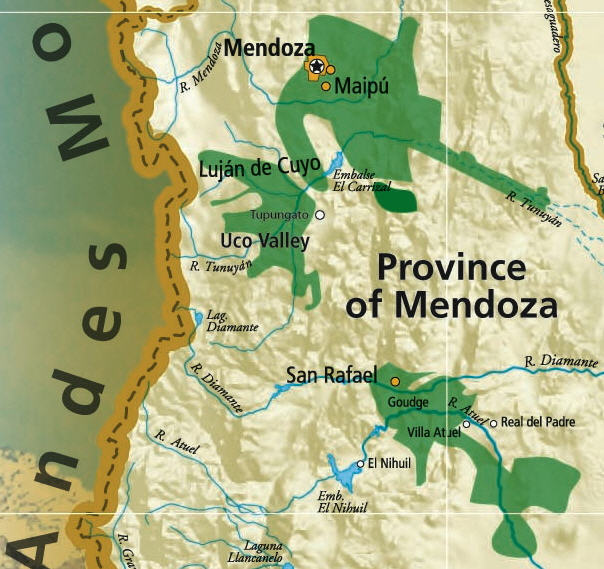 According to Wines of Argentina, sales of
malbec—the principal varietal here—grew worldwide in
sales by double digits from 2004 through 2011; the
number of cases exported to the U.S. more than doubled
from 2007 through 2012. Argentina is now the world’s
fifth largest wine producer, at a time when the global
wine market is glutted.
According to Wines of Argentina, sales of
malbec—the principal varietal here—grew worldwide in
sales by double digits from 2004 through 2011; the
number of cases exported to the U.S. more than doubled
from 2007 through 2012. Argentina is now the world’s
fifth largest wine producer, at a time when the global
wine market is glutted.
Argentina’s last financial crash, in 2002,
actually benefited the wine industry because the
devalued peso made wines cheaper for export and falling
real estate prices made vineyard land cheap.
Seventy percent of Argentina’s wines come from
the Mendoza region, whose terrain is desert-like and
whose 900 vineyards spread over 370,500 acres are
planted up to 5,777 feet, all of them needing
irrigation--factors that help combat the effects of
global warming and the warm and cold ocean currents
called el niño
and la niña.
The high desert soil and low humidity also help keep
phylloxera blight at bay.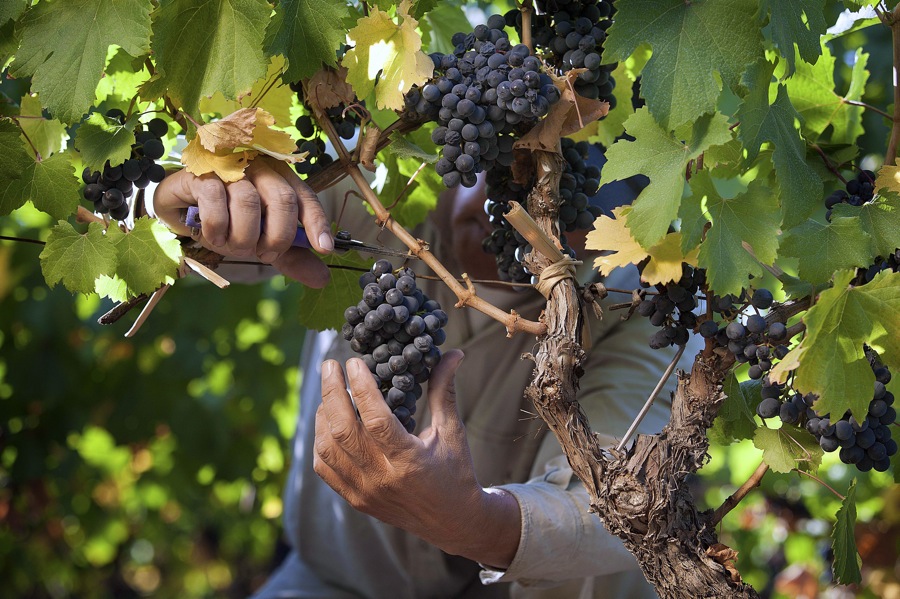
A number of highly praised labels are now coming
out of Argentina, including Bodegas Salentein and BenMarco. But none
has the pedigree or clout of Nicolas Cateña
Family Estates, with vineyards throughout Mendoza.
Nicolas Cateña founded the winery in 1902 and is
considered one of the prime movers of Argentine’s wine
industry.
His great granddaughter, Dr. Laura Cateña,
is both managing director of the company as well as a
remarkable woman in her own right, having graduated
magna cum laude in biology from Harvard and earning a
medical degree in emergency care from Stamford. Married
to another ERD doctor and mother of three children, she
splits her time between her practice in San Francisco
and her family’s winery in Mendoza.
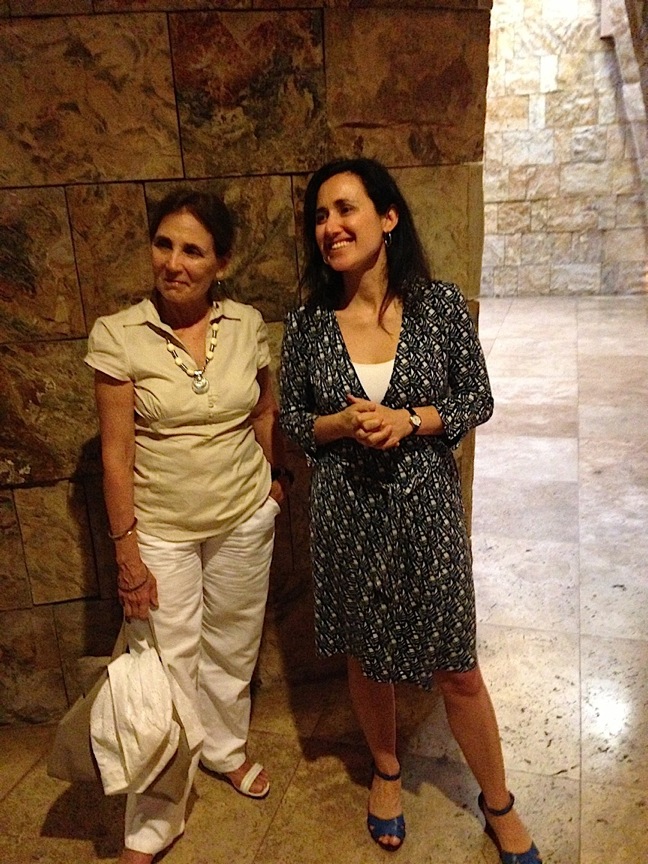 “My personal motto
is ‘Hard on issues, soft on people,” she told me on a
visit to her Cateña Zapata winery. “We constantly
work on quality through rigorous blending. A bottle of
wine is like an orchestra: the instruments are all
wonderful on their own, but together they create a truly
beautiful sound.”
“My personal motto
is ‘Hard on issues, soft on people,” she told me on a
visit to her Cateña Zapata winery. “We constantly
work on quality through rigorous blending. A bottle of
wine is like an orchestra: the instruments are all
wonderful on their own, but together they create a truly
beautiful sound.”
The family was also a pioneer, starting in 1994,
in making malbec—usually a grape used for softening
cabernet in Bordeaux-- now Argentina’s most admired
varietal. Beginning in 2001, Dr. Cateña brought
her scientific knowledge to bear on improving malbec to
the point where it supplanted cabernet sauvignon as
their principal varietal. Their high-altitude
Cateña Zapata vineyards now produce some of the
most prestigious wines in Argentina, none of them
topping 14.5 percent alcohol “We hate high alcohol!” Dr.
Cateña insisted.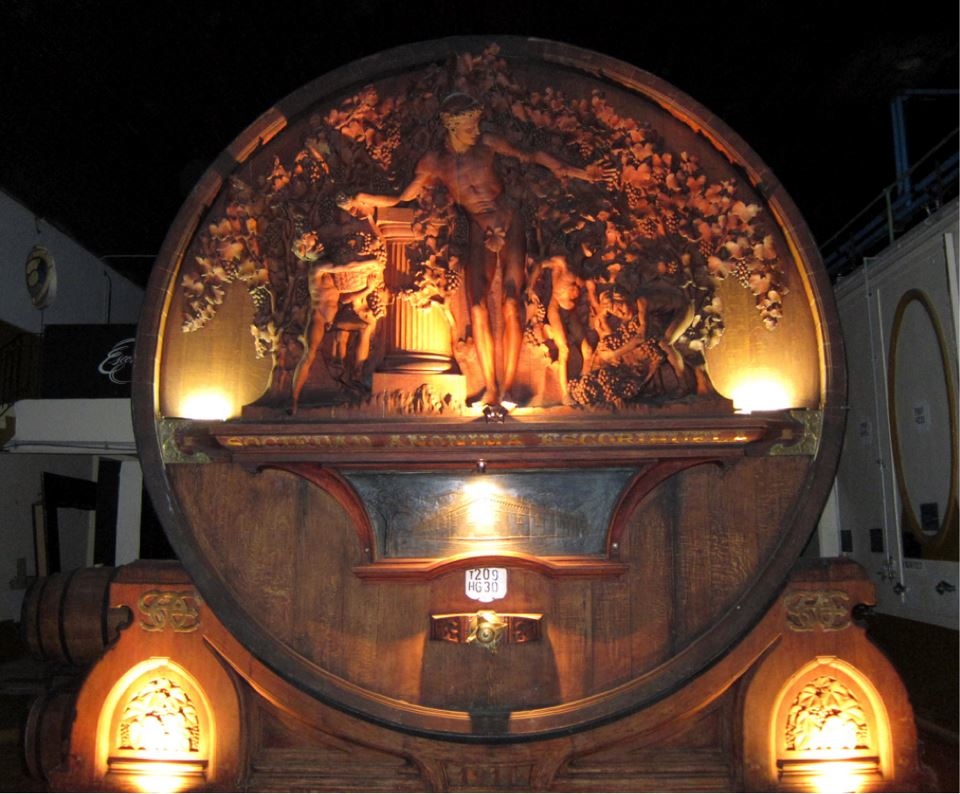
Of those I tasted, the Nicasia Vineyard Malbec
2009 and the Adrianna Vineyard Lot 9 Malbec 2009 were
outstanding, big bold malbecs but softer and fruitier
than the inky, malbec-based Cahors wines of France.
Laura Catena and her
mother Elena Maza
Cateña also owns two
lesser-priced lines that really hit that sweet spot in
the current global market. Don Miguel Gascon wines use
malbec along with grapes like bonarda, syrah and
cabernet sauvignon to make bold, tannic wines with fruit
up front and a fine balance, just the thing for the
Argentine beef that 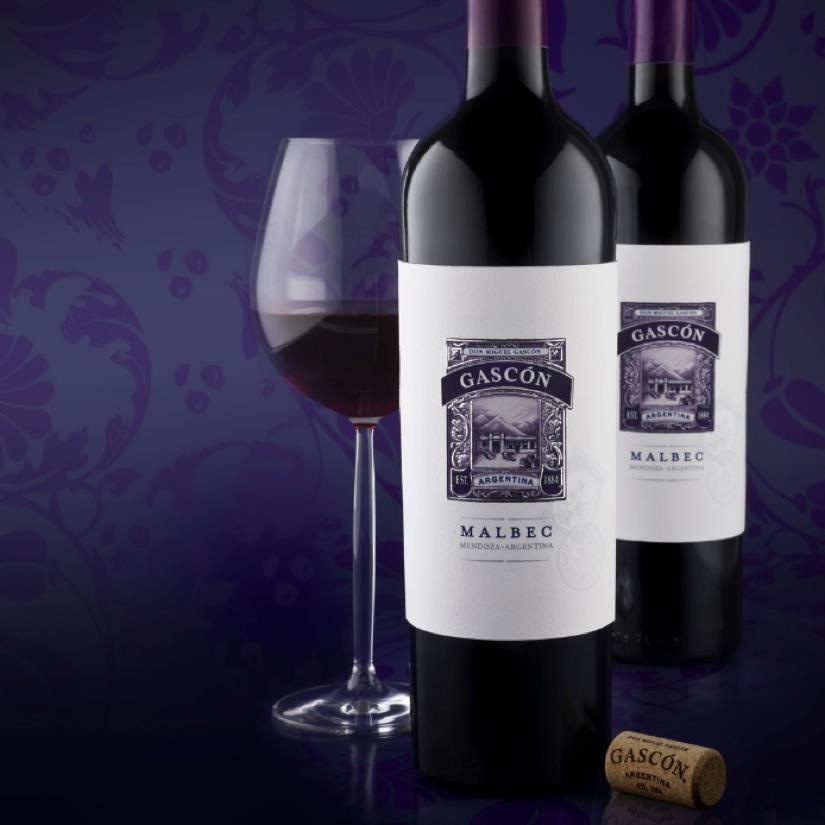 dominates every
meal and menu here.
The Gascon wines sell for $15 a bottle and taste
like they could sell for twice that.
dominates every
meal and menu here.
The Gascon wines sell for $15 a bottle and taste
like they could sell for twice that.
Cateña’s third winery is Alamos, whose
winemaker, Felipe Stahlschmidt contends that his avid
mountain climbing in the Andes sharpens his senses for
blending grapes from different vineyards. “The mountains
are always there to remind me of the nature of the The
Alamos wines include a well-rounded Seleccion Malbec
2011 ($20), along with a remarkably complex cabernet
sauvignon 2012, a good clean 2012 chardonnay, and, a
real delight, a torrontes, a white varietal with
delicious spice, layers of stone fruit flavors, and a
marvelous bouquet.
This is a textbook example of what can be done
with a once negligible grape already widely grown in
Argentina that might well
become the next big white varietal, in the
style of viognier or gruner-veltliner.
All the more remarkable is that, except the
Selection Malbec, all the Alamos wines sell for just
$13. At that price you can find good white and red wines
in the market from Italy, Chile, even Bordeaux, but
these Argentinean varietals are very distinct, with
their own unique flavors and styles that fully express
their location and the way modest grape like malbec and
torrontes can become revelations in the glass.
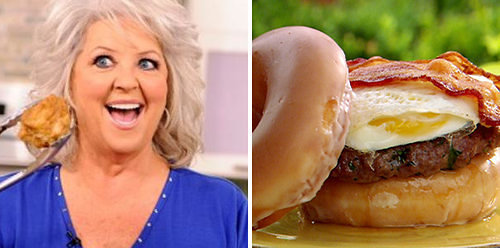 IS THERE NO
ONE
IS THERE NO
ONE WE CAN TRUST ANYMORE?
Last October, Paula Deen claimed on TV she had invented the doughnut hamburger (left), claiming "It came by accident, it happened by accident y'all" and that on a whim she decided to use doughnuts instead of hamburger buns because they were "harder than my arteries." But her son Jamie Deen now contends in an interview it is not their mother's recipe, saying, "That was a Minor League Baseball thing, and my mom did like a spoof on it. . . . I have never tasted or seen my mom ever make a Krispy Kreme cheeseburger in my life."
BUT THEN
AGAIN. . . THERE'S ALWAYS THE WHOLLY OBJECTIVE
GILES COREN!
Restaurant critic for the London Times,
Giles Coren (right),
gave the new London branch of NYC's Balthazar 0 out
of 10 points for food, writing, "I had hoped that London
was too sophisticated now to fall for this sort of
thing, but the critics seem to be going wild for it.
The food
at Balthazar comes out of "truly the worst kitchen to open
in London since the arrival of McDonald's. I am fed
up with the city of my birth, life and eventual
probable death being treated as a dustbin for the
pale shadows of restaurants that have done well
elsewhere. All these feeble replicas of places by
Ducasse, Robuchon, Wolfgang Puck, Vong Wotsisface,
Daniel Boulud, not to mention a thousand half-baked
barbecue, burger and fast-food fads." He then
said his media colleagues' praise for Balthazar was
"the greatest mass delusion since nazism."
Any of John Mariani's
books below may be ordered from amazon.com.
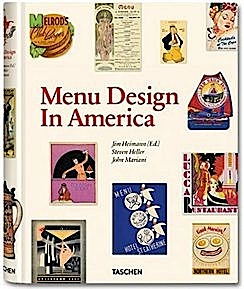 |
My latest book, which just won the prize for best book from International Gourmand, written with Jim Heimann and Steven Heller, Menu Design in America, 1850-1985 (Taschen Books), has just appeared, with nearly 1,000 beautiful, historic, hilarious, sometimes shocking menus dating back to before the Civil War and going through the Gilded Age, the Jazz Age, the Depression, the nightclub era of the 1930s and 1940s, the Space Age era, and the age when menus were a form of advertising in innovative explosions of color and modern design. The book is a chronicle of changing tastes and mores and says as much about America as about its food and drink.
“Luxuriating vicariously in the pleasures of this book. . . you can’t help but become hungry. . .for the food of course, but also for something more: the bygone days of our country’s splendidly rich and complex past. Epicureans of both good food and artful design will do well to make it their coffee table’s main course.”—Chip Kidd, Wall Street Journal.
“[The menus] reflect the amazing craftsmanship that many restaurants applied to their bills of fare, and suggest that today’s restaurateurs could learn a lot from their predecessors.”—Rebecca Marx, The Village Voice. |
"Eating Italian will never be the same after reading John Mariani's entertaining and savory gastronomical history of the cuisine of Italy and how it won over appetites worldwide. . . . This book is such a tasteful narrative that it will literally make you hungry for Italian food and arouse your appetite for gastronomical history."--Don Oldenburg, USA Today. "Italian
restaurants--some good, some glitzy--far
outnumber their French rivals. Many of
these establishments are zestfully described
in How Italian Food Conquered the World, an
entertaining and fact-filled chronicle by
food-and-wine correspondent John F.
Mariani."--Aram Bakshian Jr., Wall Street
Journal.
"Equal parts
history, sociology, gastronomy, and just
plain fun, How Italian Food Conquered the
World tells the captivating and delicious
story of the (let's face it) everybody's
favorite cuisine with clarity, verve and
more than one surprise."--Colman Andrews,
editorial director of The Daily
Meal.com. "A fantastic and fascinating
read, covering everything from the influence
of Venice's spice trade to the impact of
Italian immigrants in America and the
evolution of alta cucina. This book will
serve as a terrific resource to anyone
interested in the real story of Italian
food."--Mary Ann Esposito, host of PBS-TV's
Ciao
Italia. "John Mariani has written the
definitive history of how Italians won their
way into our hearts, minds, and
stomachs. It's a story of pleasure over
pomp and taste over technique."--Danny Meyer,
owner of NYC restaurants Union Square Cafe,
Gotham Bar & Grill, The Modern, and
Maialino.
|
 |
 |
 |
 |
 |
 |
 |
 |
❖❖❖
 Everett Potter's Travel Report:
Everett Potter's Travel Report: 
 Eating Las Vegas
is the new on-line site for Virtual Gourmet
contributor John A. Curtas., who since 1995
has been commenting on the Las Vegas food
scene and reviewing restaurants for Nevada
Public Radio. He is also the
restaurant critic for KLAS TV, Channel 8 in
Las Vegas, and his past reviews can be
accessed at KNPR.org.
Click on the logo below to go directly to
his site.
Eating Las Vegas
is the new on-line site for Virtual Gourmet
contributor John A. Curtas., who since 1995
has been commenting on the Las Vegas food
scene and reviewing restaurants for Nevada
Public Radio. He is also the
restaurant critic for KLAS TV, Channel 8 in
Las Vegas, and his past reviews can be
accessed at KNPR.org.
Click on the logo below to go directly to
his site.

Tennis Resorts Online: A Critical Guide to the World's Best Tennis Resorts and Tennis Camps, published by ROGER COX, who has spent more than two decades writing about tennis travel, including a 17-year stretch for Tennis magazine. He has also written for Arthur Frommer's Budget Travel, New York Magazine, Travel & Leisure, Esquire, Money, USTA Magazine, Men's Journal, and The Robb Report. He has authored two books-The World's Best Tennis Vacations (Stephen Greene Press/Viking Penguin, 1990) and The Best Places to Stay in the Rockies (Houghton Mifflin, 1992 & 1994), and the Melbourne (Australia) chapter to the Wall Street Journal Business Guide to Cities of the Pacific Rim (Fodor's Travel Guides, 1991).


MARIANI'S VIRTUAL GOURMET
NEWSLETTER is published weekly. Editor/Publisher: John
Mariani.
Contributing Writers: Christopher Mariani, Robert Mariani,
John A. Curtas, Edward Brivio, Mort Hochstein,
Suzanne Wright, and Brian Freedman. Contributing
Photographers: Galina Stepanoff-Dargery,
Bobby Pirillo. Technical Advisor: Gerry McLoughlin.
© copyright John Mariani 2013
